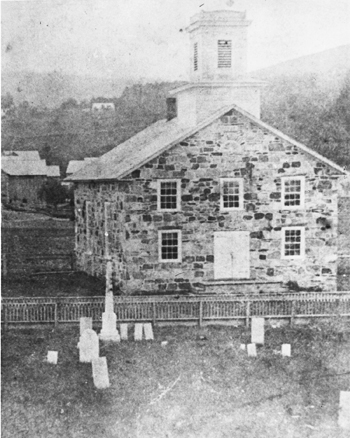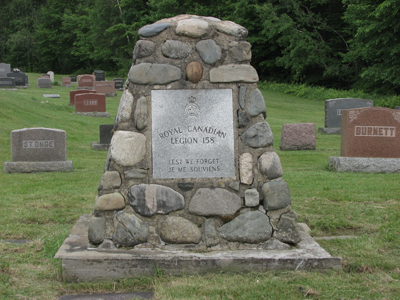 At the time when Sutton Flats was no more than a hamlet, the pioneer families buried their dead in a cemetery situated in front of Olivet Church. It was only in 1855 that today’s Grace and Fairmount cemeteries, located higher up on Maple Street (just in front of Highland) were created.
At the time when Sutton Flats was no more than a hamlet, the pioneer families buried their dead in a cemetery situated in front of Olivet Church. It was only in 1855 that today’s Grace and Fairmount cemeteries, located higher up on Maple Street (just in front of Highland) were created.
The headstones from the cemetery at Olivet were transferred to these new burial grounds most likely in the 1870s. No visible traces of the first cemetery remain with only an old photo attesting to its existence. The remains of these pioneers are still there.
Some 55 monuments, dating from before 1855, were relocated. The oldest dates from 1810 and honours the memory of Louisa, wife of Solomon Squire who represented the Methodists when the agreements were signed relative to the land where the Olivet Church was built.
In all likelihood this first cemetery contained more than 55 deceased. It is most likely that the damaged headstones and wooden crosses were not relocated. There also may very well have been some deceased that were buried without having their tomb marked by a headstone.
So it is now to Grace Cemetery, reserved for Anglicans, and Fairmount, for those of other protestant denominations, that we must look to retrace the pioneer families of Sutton Flats. The headstones transferred from the first cemetery are scattered in the oldest sections of these grounds.
In Grace Cemetery, we find the Billings, Frary, Powers, Spaulding, Squire, and Sweet families in particular, while Methodists, Baptists, and other protestant denominations are in Fairmount Cemetery. Some examples of these include the Bresee, Cutter, Dyer, Hubbard, Hurlburt and McAllister families.
 Jana Nutt and Moses Mills, parents of miller Reuben Mills, are among the pioneer families. They were buried at Grace Cemetery in 1856 and 1859, respectively. Reuben was buried in 1903 in Fairmount alongside his wife Ruth Sweet and his son Frederick who passed away in 1898 at the age of 48.
Jana Nutt and Moses Mills, parents of miller Reuben Mills, are among the pioneer families. They were buried at Grace Cemetery in 1856 and 1859, respectively. Reuben was buried in 1903 in Fairmount alongside his wife Ruth Sweet and his son Frederick who passed away in 1898 at the age of 48.
Located in Fairmount Cemetery, is the Legion Cemetery where soldiers are buried at their requests. This includes around 40 monuments surrounding a central cairn honouring the soldiers and their spouses.
The old Olivet Cemetery has since been transformed into a park by virtue of a clause in the contract signed when the Adventists purchased the church in 1876. The clause stipulated that the western grounds that served as a cemetery must always remain a public park. In 1910, the park was ceded to the Town charged with the responsibility of ensuring the tranquility of the site, prohibiting certain activities such as the installation of a skating rink or baseball field.
 The park was dedicated to the soldiers who lost their lives in the great wars of the 20th century. Interestingly, no mention is made of the fact that the bones of the pioneer families of Sutton still lie beneath, an omission needing fixing.
The park was dedicated to the soldiers who lost their lives in the great wars of the 20th century. Interestingly, no mention is made of the fact that the bones of the pioneer families of Sutton still lie beneath, an omission needing fixing.
Read also the article in the Voix de l’Est regarding the conference held on February 21st 2016 by the bioarcheologist Robert Larocque.
Available to purchase the two volumes Le patrimoine funéraire, reflet de l’histoire des gens de Sutton, Phase I and Phase II in our online store.
